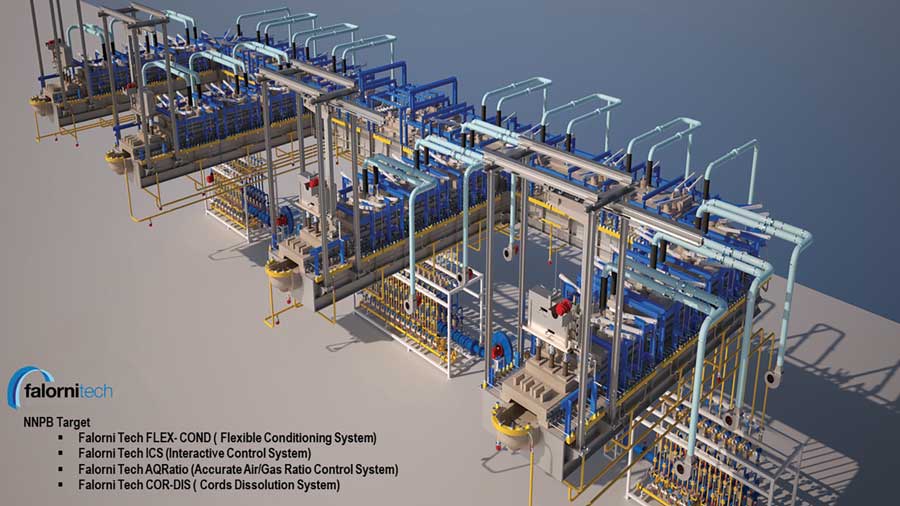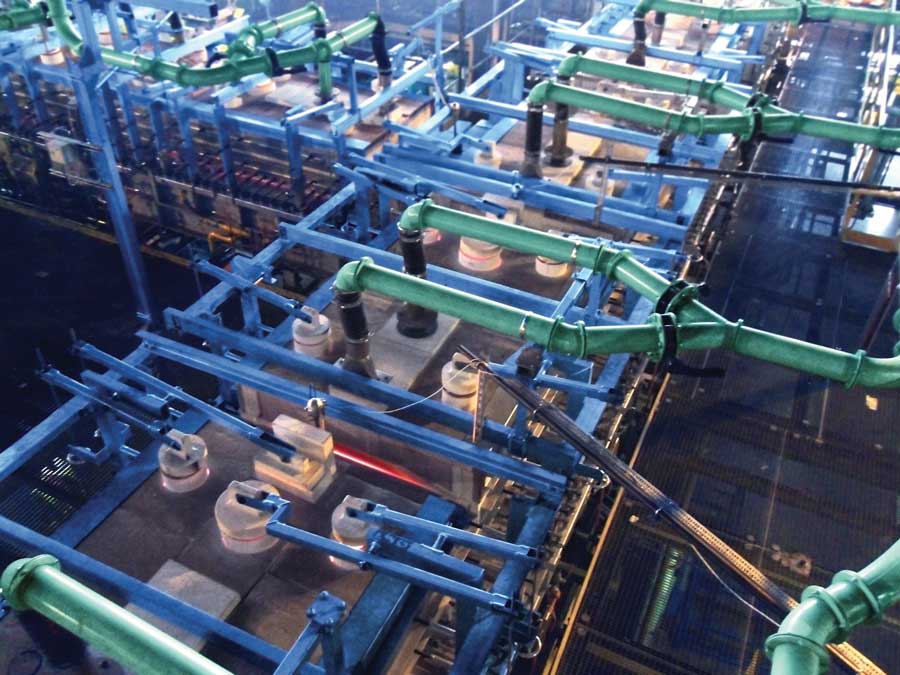Lightweight containers made by NNPB are the strictest target of every container glass producer. Falorni Tech presents its Flexible Glass Conditioning System to make NNPB production possible. This customer-driven solution is crucial for achieving suitable thermal homogeneity at the spout entry.
 |  |
The ability to be flexible and agile is one of the key qualities to be competitive on the glass container market: glass containers have to be maximally light, as well as less expensive, and at the same time they have to withstand maximal mechanical loads, greater internal pressure, thermal shocks (pasteurisation), etc. Glass containers wanting to be able to meet these requirements must, apart from being a well-designed container, achieve also excellent glass distribution (uniform thickness of glass container wall), which can be achieved by the NNPB (narrow neck press and blow process) production procedure.
THE NNPB PROCESS
Compared with the conventional Blow-Blow process, NNPB demands more rigorous requirements regarding process variables and general set-up. Nevertheless, it should be emphasised that despite the relevance of a cutting-edge IS machine, the key issue in NNPB production is the thermal homogeneity of the melted glass achieved in the conditioning forehearth.
Suitable thermal homogeneity can only be achieved by means of the proper combination of technologies that involve the whole forehearth. The Flexible Glass Conditioning System by Falorni Tech has been developed to serve this objective: first and foremost, glassmakers wanting to turn their production into NNPB must be sure of their glass conditioning system performance. The FLEX-COND system, in fact, represents the optimal combination of technologies, properly upgraded since 2010, that works to reach the highest Thermal Homogeneity Index (THI) level, with values exceeding 98 per cent with flint glass.

FLEX-COND FOREHEARTHS
FLEX-COND forehearths channel zones superstructure is designed with a winged roof profile that creates independent and separated areas across the channel width. This enables to manage the cooling and heating effect separately, not only within the channel length but within each and every single zone (two-dimensional control of heating/cooling distribution). The superstructure is then provided with a composite ducting system in which hot gases and/or cold air flow by means of the action of dampers and forced air.
The FLEX-COND superstructure has a modular design and can be used both in distributors and forehearths. The standard design size is for channel width from 26” to 48”. Tailored and bigger dimensions can be designed, reaching up to 54” (tandem massive production). The geometry of the forehearth (width, length) is calculated considering the required range of pull rate, glass colour, inlet conditions, and layout, which means that there is normally not a straight and unique solution. The production capacity required for one single forehearth can range from 30 tons/day (smallest units) up to more than 200 tons/day, for the biggest and massive production of containers.
HOW DOES FLEX-COND WORK?
When the glass reaches the channel entrance, the mission of the forehearth itself is to carry the glass to the spout entrance at the required temperature, while granting the most homogeneous temperature in the mass.
As every operator knows, the issue is to determine the suitable energy setting along the forehearth, which grants the right balance among Forced heat supply (combustion), Natural heat losses (heat losses through the walls), and Forced heat losses (cooling). Being each forehearth of invariable geometry (length, width, and zone arrangement cannot be modified during operation), the only possibility to manage glass conditioning is to modify the combination of these three energy contributions. FLEX-COND allows to manage the forehearth superstructure heating/cooling geometry with a large number of combinations that result in the synchronized effect of the combustion and the cooling functions. The operator can ‘drive’ the glass temperature profile by reading the nine-points grid temperatures and then adjusting, easily and without a particular setting, forehearth zoning up to the achievement of the required performance. FLEX-COND, or Flexible Conditioning, is exactly this concept: finding the forehearth set-up easily and quickly within any pull range of the channel, in function of the number of cavity and gob weight.
The operator can decide to heat channel sides while the central section can provide ‘no heating’ or, also, ‘cooling’ in each zone. One of the key features of the FLEX-COND is the possibility to manage in the middle section Direct Cooling or Indirect Cooling depending on glass characteristics (colour and oxidation) or temperature target. FLEX-COND forehearths can process any kind of oxidised or reduced glass (Flint, Green, Amber, Dead Leaf, etc.) without any particular setting, granting the highest level of Thermal Homogeneity Index THI.
FLEX-COND IS A COMBINATION OF INTEGRATED TECHNOLOGIES
The right concept and a rigorous design path are the cornerstones of FLEX-COND, which embeds integrated solutions that contribute to the overall performance of the glass conditioning system.
Channel heating is supported by a combustion system based on Falorni Tech AQRatio (Accurate Air/Gas Ratio Control System). This system is designed to guarantee constant and stable
air/gas ratio at any heating range. The airflow is controlled by a servo linear flow valve which provides repeatable and exact flow value within the entire range of action. The Gas flow is controlled through a servo-mechanical actuator by which the gas flow amount is linearly proportional to the airflow at any flow range. The air/gas ratio is kept constant during the regulation fluctuations driven by the temperature profile demand and is independent from the pressure losses in the air/gas mixture line downstream the regulation skid due to fouling in the pipe or in the burners.
FLEX-COND is supported by Falorni Tech ICS (Interactive Control System), a controller based on a unique technology that supports the whole conditioning phase.
Falorni Tech’s IT Team is developing the next version of ICS in cooperation with the University of Pisa: it is conceived to generate a database of experience directly from daily in-the-field use, as a platform to enhance efficiency by providing quick response for problem-solving, fast setting, sharing of experience. A new controller philosophy, which provides the standard control capabilities with additional features such as the systematisation of logical decisions for operator risk reduction, support for the operator regarding process status and data reading, automatic control of working parameters to reduce to the occurrence of damages/shutdowns. Falorni Tech ICS is conceived as a concrete support for operators, who will be able to increase the efficiency and efficacy of the system in terms of glass quality, energy efficiency, thermal homogeneity and boost the production output.
Last but not least, Falorni Tech’s COR-DIS (Cords Dissolution System) is a stirring device designed to be used in all forehearths. which can be equipped with from two to four stirrers and allows easy operation and maintenance. The system performs dispersion by mixing the impurities present in the bottom of the forehearth and allows to set the stirrer with an inclination, boosting bottom glass mixing.

Falorni Tech
www.falornitech.com





